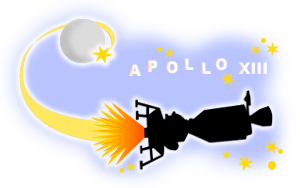
Episode 4 : "Springs in Space"
Today's theme is "Springs in Space". You may wonder if there are springs in space at all. Actually, yes, there are. Indeed, springs exist on the planet we live on when looked from outer space. One of them is the "atmosphere" and the other is "gravitation". Atmosphere and gravitation play a role as "pushing force" and a "pulling force" respectively, as described in the previous column: "Springs" are like Sumo Wrestlers.

I guess many of you have seen the movie "Apollo 13", which was released worldwide in 1995. (I saw it on a widescreen in the Ford Museum near Detroit about three years ago. At that time, I had visited Detroit to see the automobile exhibition held near the Museum.) On April 11, 1970, Apollo 13 lifted off for the Moon with Commander Jim Lovell and other astronauts. An explosion occurred about 56 hours later (320,000 km from the Earth, 60,000 km to the moon). Part of fuel cell broke down, and it seemed almost impossible to return to the Earth while maintaining all the functions of the spacecraft only with the remaining electricity. (Without electricity, oxygen cannot be produced. In addition, it is extremely cold in the spacecraft.) How on earth did Apollo 13 return safely to the Earth?

pace scientists were immediately sent from MIT, NASA, and other laboratories and they came to the conclusion that Apollo 13 should "go around the moon and headed back toward Earth." No wonder the spacecraft crew was strongly against the idea. Even if they head back directly toward Earth (which requires 90 hours), they may run out of oxygen. If they head for the moon, and go around the moon, and then back to the Earth, it is quite a long trip. Why did the scientists think "going around the moon" is the best way? The answer is "spring". The scientists thought the moon serves as a spring ----- if Apollo 13 "uses the moon as a spring, it can return to the Earth" at a very high speed like a boomerang. The spacecraft (the crew had already been in the lunar landing craft) went around the far side of the moon (the allowable angle of the spacecraft entering to the moon was only 2°), and then headed for the Earth as if it was knocked off the moon. As the spacecraft got closer to the Earth, the speed increased (also with the help of the gravitation of the Earth) and it was 40,000 kilometers per hour when the spacecraft entered the atmosphere. This was how Apollo 13 returned to Earth.
With the advance of research, it has gradually become clear that a variety of springs exist in space. For example, there is a "cosmic string", which has a width of 10-30cm (even smaller than that of elementary particles) and a weight of 100 million tons times 100 million per 1 cm. Other springs in space include dark matter, pulsars, quasars, the Great Wall, wormholes, dark halos, and MACHO. "We do not realize what we have on earth until we leave it," said Jim Lovell, the Commander of Apollo 13.

Well, so far for today. I think I talked about it too much (but I still want to talk more about). Don't miss the next column that will appear in January 2006. Have a happy new year, everyone!
Written by Banekko (a child of spring)




